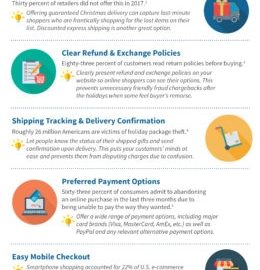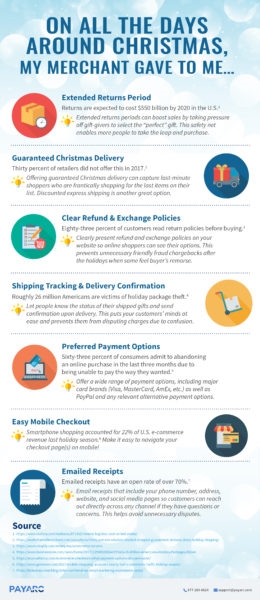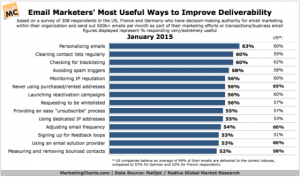— November 11, 2018
Some experts are predicting a 15% year-over-year (YoY) increase in online sales over the 2017 holiday season. Several factors are expected to play into this growth, including the surge of mobile shopping and voice search, anticipation of heavy discounting, and a thriving economy. With a 3% GDP growth rate expected to round out 2018, consumer sentiment is nearing early-2000s levels. Each of these elements position online retail to thrive during the Q4 holiday season, making it essential for online retailers to ensure they have streamlined operations and processes in place to withstand heavy volume.
Here are several factors for merchants to consider for an optimal 2018 holiday season.
Mobile Checkout Needs to be on the Nice List
With mobile accounting for over half of online transactions, optimizing your site for mobile shopping is a no-brainer, especially during the holidays. Mobile apps have a major stake in the game, with in-app transactions experiencing a 30% YoY increase. More importantly, that number increases for omnichannel retailers that actively promote their app; those retailers see mobile purchases accounting for up to 65% of their transactions.
What does this mean for retailers? Mobile is increasingly becoming the preferred way to shop—and pay. Online and omnichannel merchants should consider the following tips during the holidays to optimize for mobile:
- Be finger-friendly: optimize buttons and scrolling for fingers rather than for a mouse.
- Simplify checkout: consider breaking checkout into multiple, easy-to-use pages rather than a long, scrolling form.
- Provide essential info: empower customers by providing all the info they need on product pages, including original and sales prices, size chart, good product photos, return policies, user reviews, inventory available, and promotional information.
- Be bigger, brighter: CTAs, text, form fields, and other page elements should be big enough for a finger tap and legible enough to read on a small screen. Elements that are too small can lead to cart abandonment.
Payment Gateway
Ecommerce merchants understand that payment gateways are necessary to process online transactions; however, having the right gateway is critical during the busy holiday season. Working with a trusted payment processor that offers a PCI-compliant gateway can ensure that transactions are processed safely and securely, even when volume spikes during the busy holidays. Some payment gateways also enable encryption, so customers’ sensitive account information is coded and protected as it’s sent through the credit card network. Tokenization is another popular security mechanism offered, which replaces private payment data with a token that has no value on its own and can’t be exploited if somehow stolen.
Merchants are advised to use a payment gateway provided by a reputable payment processor that also offers 24/7 customer service. This can be helpful if errors occur or an issue arises with transaction processing. Merchants shouldn’t be left hanging if the payment gateway experiences issues during the holiday rush.
Fraud Tools
One area merchants should avoid skimping on is fraud prevention. As waves of consumers come out (and log on) to make a lot of holiday purchases, bad actors are lurking in the dark corners of the web looking for vulnerabilities to exploit. Fraud spikes during the Q4 holidays, making unprotected merchants a prime target.
Merchants should always implement authentication protocol and fraud prevention tools:
- Address Verification System (AVS): This protocol checks the cardholder’s address and zip code against the same information on file with the card-issuing bank. A mismatch raises a flag, allowing the merchant to contact the customer to verify additional information or to decline the transaction.
- Card Verification Value 2 (CVV2): This process asks the customer for the three- or four-digit security code on the back of the card. Asking for this number helps merchants confirm that the person attempting to make the purchase is in possession of the actual card.
- 3D Secure 2.0 (3DS2): This updated protocol allows consumers to directly authenticate with the card issuer for online transactions. It provides an additional security layer to prevent fraudulent purchases via online credit and debit cards.
Chargeback Management
Chargebacks also spike during and after the holidays, for several reasons. With cases of true fraud where a cardholder’s payment data is stolen and used to make fraudulent purchases, retailers see an influx of those cardholders reporting the fraud to their issuing banks. This initiates the chargeback process, which costs merchants in time, lost merchandise, shipping costs, fees, and fines.
Another reason for increased chargebacks is “friendly fraud.” This less malicious but equally costly type of chargeback happens when a customer has confusion about a purchase and disputes the purchase with the issuing bank. In some instances, a customer may have forgotten about an individual purchase during the holiday rush and gets confused. In other instances, a customer may not recognize the billing descriptor (merchant information ) on their monthly statement. In yet other cases, a customer may be trying to purposely defraud the store by reporting the item never received or damaged. When that happens, the issuing bank may yield to the customer if the merchant has not kept good records or shipping/delivery receipts.
Whatever the cause, chargebacks are a serious problem. Merchants should talk to their merchant account providers/payment processors about additional chargeback prevention tools they can implement during the holidays. Having a strong customer service presence can also negate chargebacks; customers who feel heard and who are able to adequately receive support for their questions and issues will be more likely to resolve issues with the merchant directly rather than to dispute a charge.
We’re rolling full-steam ahead into the busiest online shopping time of the year. Ensuring your ecommerce ducks are in a row will make for a successful—and merry—holiday sales season.
Digital & Social Articles on Business 2 Community
(63)









